[/caption]
We’ve all wondered at some point or another what mysteries our Solar System holds. After all, the eight planets (plus Pluto and all those other dwarf planets) orbit within a very small volume of the heliosphere (the volume of space dominated by the influence of the Sun), what’s going on in the rest of the volume we call our home? As we push more robots into space, improve our observational capabilities and begin to experience space for ourselves, we learn more and more about the nature of where we come from and how the planets have evolved. But even with our advancing knowledge, we would be naive to think we have all the answers, so much still needs to be uncovered. So, from a personal point of view, what would I consider to be the greatest mysteries within our Solar System? Well, I’m going to tell you my top ten favourites of some more perplexing conundrums our Solar System has thrown at us. So, to get the ball rolling, I’ll start in the middle, with the Sun. (None of the following can be explained by dark matter, in case you were wondering… actually it might, but only a little…)
10. Solar Pole Temperature Mismatch
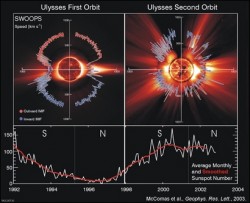
Why is the Sun’s South Pole cooler than the North Pole? For 17 years, the solar probe Ulysses has given us an unprecedented view of the Sun. After being launched on Space Shuttle Discovery way back in 1990, the intrepid explorer took an unorthodox trip through the Solar System. Using Jupiter for a gravitational slingshot, Ulysses was flung out of the ecliptic plane so it could pass over the Sun in a polar orbit (spacecraft and the planets normally orbit around the Sun’s equator). This is where the probe journeyed for nearly two decades, taking unprecedented in-situ observations of the solar wind and revealing the true nature of what happens at the poles of our star. Alas, Ulysses is dying of old age, and the mission effectively ended on July 1st (although some communication with the craft remains).
However, observing uncharted regions of the Sun can create baffling results. One such mystery result is that the South Pole of the Sun is cooler than the North Pole by 80,000 Kelvin. Scientists are confused by this discrepancy as the effect appears to be independent of the magnetic polarity of the Sun (which flips magnetic north to magnetic south every 11-years). Ulysses was able to gauge the solar temperature by sampling the ions in the solar wind at a distance of 300 million km above the North and South Poles. By measuring the ratio of oxygen ions (O6+/O7+), the plasma conditions at the base of the coronal hole could be measured.
This remains an open question and the only explanation solar physicists can currently come up with is the possibility that the solar structure in the polar regions differ in some way. It’s a shame Ulysses bit the dust, we could do with a polar orbiter to take more results (see Ulysses Spacecraft Dying of Natural Causes).
9. Mars Mysteries
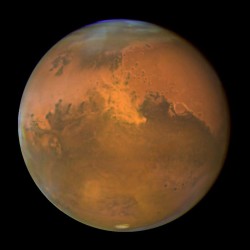
Why are the Martian hemispheres so radically different? This is one mystery that had frustrated scientists for years. The northern hemisphere of Mars is predominantly featureless lowlands, whereas the southern hemisphere is stuffed with mountain ranges, creating vast highlands. Very early on in the study of Mars, the theory that the planet had been hit by something very large (thus creating the vast lowlands, or a huge impact basin) was thrown out. This was primarily because the lowlands didn’t feature the geography of an impact crater. For a start there is no crater “rim.” Plus the impact zone is not circular. All this pointed to some other explanation. But eagle-eyed researchers at Caltech have recently revisited the impactor theory and calculated that a huge rock between 1,600 to 2,700 km diameter can create the lowlands of the northern hemisphere (see Two Faces of Mars Explained).
Bonus mystery: Does the Mars Curse exist? According to many shows, websites and books there is something (almost paranormal) out in space eating (or tampering with) our robotic Mars explorers. If you look at the statistics, you would be forgiven for being a little shocked: Nearly two-thirds of all Mars missions have failed. Russian Mars-bound rockets have blown up, US satellites have died mid-flight, British landers have pock-marked the Red Planet’s landscape; no Mars mission is immune to the “Mars Triangle.” So is there a “Galactic Ghoul” out there messing with our ‘bots? Although this might be attractive to some of us superstitious folk, the vast majority of spacecraft lost due to The Mars Curse is mainly due to heavy losses during the pioneering missions to Mars. The recent loss rate is comparable to the losses sustained when exploring other planets in the Solar System. Although luck may have a small part to play, this mystery is more of a superstition than anything measurable (see The “Mars Curse”: Why Have So Many Missions Failed?).
8. The Tunguska Event
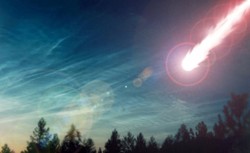
What caused the Tunguska impact? Forget Fox Mulder tripping through the Russian forests, this isn’t an X-Files episode. In 1908, the Solar System threw something at us… but we don’t know what. This has been an enduring mystery ever since eye witnesses described a bright flash (that could be seen hundreds of miles away) over the Podkamennaya Tunguska River in Russia. On investigation, a huge area had been decimated; some 80 million trees had been felled like match sticks and over 2,000 square kilometres had been flattened. But there was no crater. What had fallen from the sky?
This mystery is still an open case, although researchers are pinning their bets of some form of “airburst” when a comet or meteorite entered the atmosphere, exploding above the ground. A recent cosmic forensic study retraced the steps of a possible asteroid fragment in the hope of finding its origin and perhaps even finding the parent asteroid. They have their suspects, but the intriguing thing is, there is next-to-no meteorite evidence around the impact site. So far, there doesn’t appear to be much explanation for that, but I don’t think Mulder and Scully need be involved (see Tunguska Meteoroid’s Cousins Found?).
7. Uranus’ Tilt
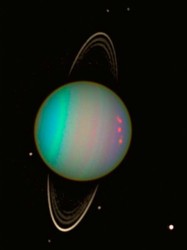
Why does Uranus rotate on its side? Strange planet is Uranus. Whilst all the other planets in the Solar System more-or-less have their axis of rotation pointing “up” from the ecliptic plane, Uranus is lying on its side, with an axial tilt of 98 degrees. This means that for very long periods (42 years at a time) either its North or South Pole points directly at the Sun. The majority of the planets have a “prograde” rotation; all the planets rotate counter-clockwise when viewed from above the Solar System (i.e. above the North Pole of the Earth). However, Venus does the exact opposite, it has a retrograde rotation, leading to the theory that it was kicked off-axis early in its evolution due to a large impact. So did this happen to Uranus too? Was it hit by a massive body?
Some scientists believe that Uranus was the victim of a cosmic hit-and-run, but others believe there may be a more elegant way of describing the gas giant’s strange configuration. Early in the evolution of the Solar System, astrophysicists have run simulations that show the orbital configuration of Jupiter and Saturn may have crossed a 1:2 orbital resonance. During this period of planetary upset, the combined gravitational influence of Jupiter and Saturn transferred orbital momentum to the smaller gas giant Uranus, knocking it off-axis. More research needs to be carried out to see if it was more likely that an Earth-sized rock impacted Uranus or whether Jupiter and Saturn are to blame.
6. Titan’s Atmosphere
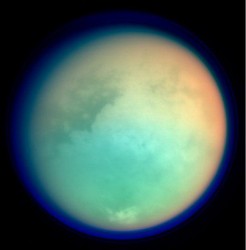
Why does Titan have an atmosphere? Titan, one of Saturn’s moons, is the only moon in the Solar System with a significant atmosphere. It is the second biggest moon in the Solar System (second only to Jupiter’s moon Ganymede) and about 80% more massive than Earth’s Moon. Although small when compared with terrestrial standards, it is more Earth-like than we give it credit for. Mars and Venus are often cited as Earth’s siblings, but their atmospheres are 100 times thinner and 100 times thicker, respectively. Titan’s atmosphere on the other hand is only one and a half times thicker than Earth’s, plus it is mainly composed of nitrogen. Nitrogen dominates Earth’s atmosphere (at 80% composition) and it dominates Titans atmosphere (at 95% composition). But where did all this nitrogen come from? Like on Earth, it’s a mystery.
Titan is such an interesting moon and is fast becoming the prime target to search for life. Not only does it have a thick atmosphere, its surface is crammed full with hydrocarbons thought to be teeming with “tholins,” or prebiotic chemicals. Add to this the electrical activity in the Titan atmosphere and we have an incredible moon with a massive potential for life to evolve. But as to where its atmosphere came from… we just do not know.
5. Solar Coronal Heating

Why is the solar atmosphere hotter than the solar surface? Now this is a question that has foxed solar physicists for over half a century. Early spectroscopic observations of the solar corona revealed something perplexing: The Sun’s atmosphere is hotter than the photosphere. In fact, it is so hot that it is comparable to the temperatures found in the core of the Sun. But how can this happen? If you switch on a light bulb, the air surrounding the glass bulb wont be hotter than the glass itself; as you get closer to a heat source, it gets warmer, not cooler. But this is exactly what the Sun is doing, the solar photosphere has a temperature of around 6000 Kelvin whereas the plasma only a few thousand kilometres above the photosphere is over 1 million Kelvin. As you can tell, all kinds of physics laws appear to be violated.
However, solar physicists are gradually closing in on what may be causing this mysterious coronal heating. As observational techniques improve and theoretical models become more sophisticated, the solar atmosphere can be studied more in-depth than ever before. It is now believed that the coronal heating mechanism may be a combination of magnetic effects in the solar atmosphere. There are two prime candidates for corona heating: nanoflares and wave heating. I for one have always been a huge advocate of wave heating theories (a large part of my research was devoted to simulating magnetohydrodynamic wave interactions along coronal loops), but there is strong evidence that nanoflares influence coronal heating too, possibly working in tandem with wave heating.
Although we are pretty certain that wave heating and/or nanoflares may be responsible, until we can insert a probe deep into the solar corona (which is currently being planned with the Solar Probe mission), taking in-situ measurements of the coronal environment, we won’t know for sure what heats the corona (see Warm Coronal Loops May Hold the Key to Hot Solar Atmosphere).
4. Comet Dust

How did dust formed at intense temperatures appear in frozen comets? Comets are the icy, dusty nomads of the Solar System. Thought to have evolved in the outermost reaches of space, in the Kuiper Belt (around the orbit of Pluto) or in a mysterious region called the Oort Cloud, these bodies occasionally get knocked and fall under the weak gravitational pull of the Sun. As they fall toward the inner Solar System, the Sun’s heat will cause the ice to vaporize, creating a cometary tail known as the coma. Many comets fall straight into the Sun, but others are more lucky, completing a short-period (if they originated in the Kuiper Belt) or long-period (if they originated in the Oort Cloud) orbit of the Sun.
But something odd has been found in the dust collected by NASA’s 2004 Stardust mission to Comet Wild-2. Dust grains from this frozen body appeared to have been formed a high temperatures. Comet Wild-2 is believed to have originated from and evolved in the Kuiper Belt, so how could these tiny samples be formed in an environment with a temperature of over 1000 Kelvin?
The Solar System evolved from a nebula some 4.6 billion years ago and formed a large accretion disk as it cooled. The samples collected from Wild-2 could only have been formed in the central region of the accretion disk, near the young Sun, and something transported them into the far reaches of the Solar System, eventually ending up in the Kuiper Belt. But what mechanism could do this? We are not too sure (see Comet Dust is Very Similar to Asteroids).
3. The Kuiper Cliff
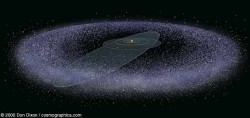
Why does the Kuiper Belt suddenly end? The Kuiper Belt is a huge region of the Solar System forming a ring around the Sun just beyond the orbit of Neptune. It is much like the asteroid belt between Mars and Jupiter, the Kuiper Belt contains millions of small rocky and metallic bodies, but it’s 200-times more massive. It also contains a large quantity of water, methane and ammonia ices, the constituents of cometary nuclei originating from there (see #4 above). The Kuiper Belt is also known for its dwarf planet occupant, Pluto and (more recently) fellow Plutoid “Makemake”.
The Kuiper Belt is already a pretty unexplored region of the Solar System as it is (we wait impatiently for NASA’s New Horizons Pluto mission to arrive there in 2015), but it has already thrown up something of a puzzle. The population of Kuiper Belt Objects (KBOs) suddenly drops off at a distance of 50 AU from the Sun. This is rather odd as theoretical models predict an increase in number of KBOs beyond this point. The drop-off is so dramatic that this feature has been dubbed the “Kuiper Cliff.”
We currently have no explanation for the Kuiper Cliff, but there are some theories. One idea is that there are indeed a lot of KBOs beyond 50 AU, it’s just that they haven’t accreted to form larger objects for some reason (and therefore cannot be observed). Another more controversial idea is that KBOs beyond the Kuiper Cliff have been swept away by a planetary body, possibly the size of Earth or Mars. Many astronomers argue against this citing a lack of observational evidence of something that big orbiting outside the Kuiper Belt. This planetary theory however has been very useful for the doomsayers out there, providing flimsy “evidence” for the existence of Nibiru, or “Planet X.” If there is a planet out there, it certainly is not “incoming mail” and it certainly is not arriving on our doorstep in 2012.
So, in short, we have no clue why the Kuiper Cliff exists…
2. The Pioneer Anomaly
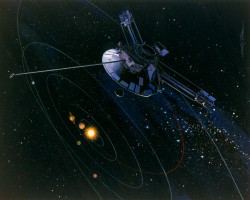
Why are the Pioneer probes drifting off-course? Now this is a perplexing issue for astrophysicists, and probably the most difficult question to answer in Solar System observations. Pioneer 10 and 11 were launched back in 1972 and 1973 to explore the outer reaches of the Solar System. Along their way, NASA scientists noticed that both probes were experiencing something rather strange; they were experiencing an unexpected Sun-ward acceleration, pushing them off-course. Although this deviation wasn’t huge by astronomical standards (386,000 km off course after 10 billion km of travel), it was a deviation all the same and astrophysicists are at a loss to explain what is going on.
One main theory suspects that non-uniform infrared radiation around the probes’ bodywork (from the radioactive isotope of plutonium in its Radioisotope Thermoelectric Generators) may be emitting photons preferentially on one side, giving a small push toward the Sun. Other theories are a little more exotic. Perhaps Einstein’s general relativity needs to be modified for long treks into deep space? Or perhaps dark matter has a part to play, having a slowing effect on the Pioneer spacecraft?
So far, only 30% of the deviation can be pinned on the non-uniform heat distribution theory and scientists are at a loss to find an obvious answer (see The Pioneer Anomaly: A Deviation from Einstein Gravity?).
1. The Oort Cloud
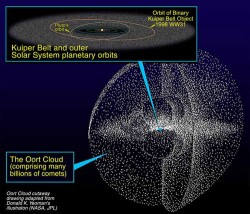
How do we know the Oort Cloud even exists? As far as Solar System mysteries go, the Pioneer anomaly is a tough act to follow, but the Oort cloud (in my view) is the biggest mystery of all. Why? We have never seen it, it is a hypothetical region of space.
At least with the Kuiper Belt, we can observe the large KBOs and we know where it is, but the Oort Cloud is too far away (if it really is out there). Firstly, the Oort Cloud is predicted to be over 50,000 AU from the Sun (that’s nearly a light year away), making it about 25% of the way toward our nearest stellar neighbour, Proxima Centauri. The Oort Cloud is therefore a very long way away. The outer reaches of the Oort Cloud is pretty much the edge of the Solar System, and at this distance, the billions of Oort Cloud objects are very loosely gravitationally bound to the Sun. They can therefore be dramatically influenced by the passage of other nearby stars. It is thought that Oort Cloud disruption can lead to icy bodies falling inward periodically, creating long-period comets (such as Halley’s comet).
In fact, this is the only reason why astronomers believe the Oort Cloud exists, it is the source of long-period icy comets which have highly eccentric orbits emanating regions out of the ecliptic plane. This also suggests that the cloud surrounds the Solar System and is not confined to a belt around the ecliptic.
So, the Oort Cloud appears to be out there, but we cannot directly observe it. In my books, that is the biggest mystery in the outermost region of our Solar System…


Oh wow, thank you Tyler and Ralph! I’m really happy you like the article 🙂 I enjoyed writing it!
Tyler – thanks for the correction, I can be a little too dependent on spellcheckers at times. As for the spherical nature of the Oort Cloud, we have guessed that it is that way from the orbital trajectories of long-period comets, but as to why it is that way I’m not sure. There is an inner Oort Cloud that is possibly in a belt shape, but the outer is a cloud is spherical. Apart from that, I’m mystified 🙂
Ralph – I think I’ll be doing more of these articles in the future, really gets the creative juices going 🙂
Cheers! Ian 😀
The best article written here. It brings back curiosity, speculation, flavor, fantasy, science, width, evaluation, questions marks to the whole universe thing.
I really loved it and enjoyed it.
Great article! Lots of interesting information (and missing information) that I knew nothing about, and a good recap on some stuff that I already knew.
I’m wondering, why would the Oort Cloud be a sphere surrounding the solar system outside of the ecliptic, while the Kuiper Belt incorporates objects that orbit mostly in the plane of the ecliptic?
It seems like if the Oort Cloud was formed from the original accretion disk of the solar system, it too should be orbiting in the plane of the ecliptic.
So why a sphere? Is it suggested that the Oort Cloud is the leavings from the original nebula that was here before the solar system’s accretion disk formed? That’s the only way I can guess at how the Oort cloud would be a sphere surrounding the solar system in all directions.
Oh, small nitpick:
“Earth’s siblings, but their atmospheres are 100 times thinner and 100 times thicker, respectfully.”
Should read “respectively.” Respectfully means you respect the thickness of Mars and Venus. Not that there’s anything wrong with respecting that, but I’m pretty sure you meant the former rather than the latter.
I learned so much from this! Thanks for sharing!
Would love to see more photography!
I love the night sky and have a Konica Minolta Digital with a nice zoom- on a good night I can get some wonderful shots. It’s time consuming- I use a Night Portrait setting and a tripod and hope I don’t jiggle the camera when I hit the shutter button!
Oh to have a telescope to aim my camera into! LOL.
Well, when it works its great and for the far away stuff- I thank you for sharing!
My site is mostly “out reach” but if you care to see some of my photography- feel free to stop by!
Katee.
I thought that in an AstronomyCast episode Pamela and Frasier discussed the retrograde spin of Venus as being due to tidal effects between the sun and earth and that it didn’t need a collision to account for it.
Hi,
“…inward periodically, creating long-period comets (such as Halley’s comet).”
Surely Halley’s comet is a short period comet?
Hi All
One misunderstanding to clear up – we think the Oort Cloud exists because of the orbital statistics of unperturbed long-period comets. The numbers peak in the very large orbit of around ~ 22,000-50,000 AU and the comets come from all directions. With the reasonable assumption that this distribution is nothing new Jan Oort reasoned they had to come from very big, circular orbits and were perturbed by passing stars into orbits falling towards the Sun.
Notice the assumption – if the comets are nothing new, but have been appearing for the last few billion years. Alternatively, as Tom van Flandern has argued, comets might come from an exploded planet in the not too distant past (c.3.2 million years ago) – but that’s just one idea based on a currently inexplicable explosion.
The alternative is that the Oort was produced from the perturbed leftovers of the forming Outer Planets – again assuming that comets aren’t a recently produced phenomena of an exploded planet. As comet dust has been radio-dated to billions of years old it’s not an unreasonable assumption that they’ve been around since the planets formed.
Wow thanks for this very informative article! 😀
Ian, You’ve said;
“One such mystery result is that the South Pole of the Sun is cooler than the North Pole by 80,000 Kelvin.”
Where?
It can’t be the photosphere, because the ‘surface temperature of the Sun is more like 5,778 K. If its the chromosphere, its temperature is about 20,000K. So I assume it is the corona or is it the solar wind itself?
As a comment, even more mysterious is the the velocity of the material ejected from the poles is twice the velocity at the equator. Furthermore, if this is true, has this always been the case. Does this observation fact have anything to do with the bipolar planetary nebulae which tend to tear through the surrounding nebulosity from the AGB phase at the two planetary poles opposing one another?
What about the hexagon on Saturn’s North Pole? It doesn’t get any more mysterious than that.
AJames,
I believe the Kelvin reference is a misprint. During the last solar cycle the magnetic north pole was 80,000 degrees Fahrenheit (44,000 celcius) or about 8 percent cooler than the south.
Data is still being poured over from the last north pole flyover last January; so nothing conclusive has been reached yet.
The sun is rather variable, and as long as the cycles are, it could be some time before anything conclusive is reached.
One thing to note. As sun spots fade away, they migrate towards the poles. So the number and frequency of spots may have an affect on polar temperatures.
I think mankind must accept that it is not able to figure everything out
We just don’t have the functioning brain capacities now or later or even much later to solve all of Life and Nature.
The only Thing we can be certain of is that there is an explanation.
We all know that every new answer or discovery creates a dozen new questions and pulls half of the previous answered subject back to unanswered status.
It seems though that we have this immeasurable capability to ask questions, wonder about things and pull out theories like a bunny out of a hat?
Infect, I think that our abilities to ask and theorize is more endless then the universe itself.
Nice article by the way.
Very interesting questions.
I wonder what lies behind, in front, left, right, north and south of the answers.
More questions I guess
And I found my place in this universe too, thanks to this site.
It’s in THIS mystery!
I believe on some of these mysteries, we should begin to look far outside our solar system. We already know there are extra-solar planets. Since our galaxy has merged with others in the past; why couldn’t Uranus have been captured during this event; from a galaxy which is tilted 90 degrees off of our own.
Same thing with comets. As our solar system moves through space it comes in contact with icy remnants from other worlds. Some end up crashing into the Sun, others come in at an angle where they are flung back out, however the Sun now has a gravity hold on them, so they enter an excentric orbit.
With Pioneers odd movements, and the sudden acceleration of other satellites as we have moved them through their trajectories; perhaps it is because…
…okay I’m going to say it. Nobody have a heart attack…
What if gravity isn’t constant?!!?
Hi!
That was a very impressive article which gave loads of food for thought for my lazying brain (since i got fed-up wiht my project :()… Thank you very much Ian for summing it up beautifully… I have some thoughts on this issue :
When we talk about the Kuiper Belt formation, now that we are redefining our theories about planetary system formation and migration theory is gaining more evidence, is it possible that as the massive bodies migrated towards the interior of the solar system, the dust particles which are the momentum carriers moved outwards and got collected at the present position. This might also explain the dust grains which are to be formed at such high temperatures. This might also in a way explain its postion in the ecliptic plane of the solar system.
And as to the Oort cloud formation, could it be the condensed remanent of our solar system primordial nebula which might explain its alignment and its distance from the centre…
It is all too interesting….we have come a long in explaining our universe and hence we can definitely unravel the mysteries in the near future,
regards,
vino
Wow, that was indepth! Great article though, lots of information…some good theories in the comments too….
If this were a “Top 11 mysteries” list, I would like to submit a suggestion to come in somwhere between 10.5 and 11:
Why did it happen? We know generally where we are in the universe. We know generally when it happened. But why did it happen? Two popular camps with opposing viewpoints argue back and forth that it was a random act of evolutionary chance vs. that it was part of an intelligent design. The “why” factor is lurking out there in a lot of questions and debates, puzzling us, bewitching us, amusing us, tormenting us, etc. “Why?” is an important question.
Other mysteries
1. Source of Heat in Jupiter. More heat leaves Jupiter than enters it from the sun. Also along the same lines, what is the long-term source of energy that drives all the storms on Jupiter?
2. Angular Momentum Distribution of Solar System. If the Solar system developed from a nebular cloud, there would be a predictable distribution of angular momentum since no one part of the cloud could be in motion too much faster than its surrounding parts. . Our solar system has its angular momentum distributed outwards towards Jupiter.
3. Why are the inner planets “rocky�. Before the observation of Planets outside our solar system, it was believed that the four inner “rocky†planets were devoid of H and He because the radiant pressure from the sun pushed these elements away from the sun. The discovery of supermassive Jupiter like planets near their Stars challenges this explanation.
John
“3. Why are the inner planets “rockyâ€?. Before the observation of Planets outside our solar system, it was believed that the four inner “rocky†planets were devoid of H and He because the radiant pressure from the sun pushed these elements away from the sun. The discovery of supermassive Jupiter like planets near their Stars challenges this explanation.”
—————–
It doesn’t challenge anything. It just demonstrates what we already know – that our observational techniques and instruments are not yet ready to detect solar systems like our own, with rocky planets close to the star and gas giants further out.
The way we detect extrasolar planets makes it far more likely to find Jupiter-sized and larger planets, close in to their stars. The fact that we’ve found many such planets is unsurprising.
“Two popular camps with opposing viewpoints argue back and forth that it was a random act of evolutionary chance vs. that it was part of an intelligent design. ”
Red Card.
My theory on why the inner planets are rocky.
Simple, because no BIG planet formed there to whisk them out of the solar system, or capture them as a moon.
Why are no rocky planets out by the gas planets? Because the big gas planets kicked them out or put them into a really excentric orbit.
This is one of those things which really cannot be answered until we get a better idea how other systems are put together.
As John pointed out; since huge gas planets have been found orbiting closer to their star than Mercury, the idea of the sun simply “blowing” away the gas from a planet is probably out the window, but not necessarily dead.
Interesting article indeed!
Speculation regarding the formation of the Oort cloud is particularly fascinating. I’ve always thought that accretion discs are formed by centrifugal forces about a rotating center of gravity. An outer spherical debris cloud would seem to suggest that while attenuating solar gravity near the heliopause issufficient to prevent small objects from evaporating into surrounding space, it’s too weak to sweep them up in its accretion disk.
Tom
Great Article. As one commenter already said, it brings a sense of mystery and wonder back to astronomy. Just what the heck is going on out there? These little mysteries add up to a big, interesting article.
Sorry for the double post. The site timed out but posted the first comment anyway, which I tried to recreate from memory. Close…
Another mystery I’d like to point out: What powers the gas giants? Afaik, all of them radiate more energy than they receive from the sun. It will remain a mystery until we figure out how their inner core works.
Very good article Ian!
I am glad you seem to have abandoned the “Sensationalist” style.
Great stuff, but what about the hexagon formation in Saturn’s pole ?? Now that is freakin’ awesome…
what if Planet Nibiru has an influence with it’s gravity, over the Pioneer probes, as it makes it’s way towards Earth? this would explain both myster no. 2 and the doom theory.
As for why the sun is “hotter” farther from the surface than at the surface — well, temperature is a measurement of the kinetic energy of particles. The massive gravity of the sun would tend to pull any gas molecules to its center. This would compress the gas closest to the sun to such an extent that it has less kinetic energy (because there would be nowhere, relatively speaking, for the molecules to move) and is “cooler.” The gas molecules away from the surface would have more freedom of movement and would show a higher temperature.
This is my theory. . . But it seems logical to me. 🙂
Mystery solved! God used a giant solar powered cordless screwdriver with an Allen (hexagonal) bit to get Saturn spinning. Be interesting to see if one is here when the ice caps melt. Hold on. There’s somebody at the front door. Whoa! Guys! You’re supposed to laugh, not burn me at the stake!
Hi All
Just a few responses to John Kulick’s mysteries
(1) Excess heat – Safir is right, as different models of gas giants produce different cooling timescales. The high pressure behaviour of hydrogen and helium is still largely a big blank. Also there might be other energy sources other than the initial gravitational collapse. Helium rain-out is one suggestion, another is natural fission reactors in the deep core.
(2) Angular momentum – most is in the planets, so the current puzzle is just how it was transferred from the collapsing Sun to the nebula disk. Magnetic coupling is one reasonable possibility – intense magnetic fields are seen in young stars and they might be sufficient. Another possibility is convection in the collapsing proto-solar cloud. Or the Sun formed separately and captured the planets from a fellow proto-star in their common birth nebula.
(3)The Inner Planets – formed without gaseous envelopes because of the bright early Sun. No mystery there. The real puzzle is how Hot Jupiters got to their current orbits, and that is explained by orbital migration, which was recently in the news. Another possibility is that captured planets on nearly hyperbolic orbits encountered retardation by a gas/dust disk which slowed them for capture, but dissipated before the planets circularised their orbits.
There’s lots of mysteries, but there’s also lots of theories on how they came about. The adventure of science is that there is so much yet to discover, and the work of science is developing experiments (lab or observational) to distinguish between all the good ideas available.
why can’t see the Oort Cloud with the Hubble Telescope?
sorry… my knowledge is limited… but i love science
Very interesting and informative article.
PS: awesome article!
Physicist Nikola Tesla was responsible for the Tunguska Explosion.
These are great mysteries of God. Praise Him!
Ummm… Maybe I’m missing something, but maybe the Voyager probes acceleration towards the Sun is caused by the Sun’s gravity??? Sorry but it just kinda jumped out at me when I read that
Great writeup, Ian. Each of these was meaty enough to be its own blog post, and makes for a perfect morning read.
Yes, Nikola Tesla was responsible for the Tunguska Explosion. Perhaps the South Pole region is colder than the North Pole region because salt water is a better conductor then earth. MOK
Gosh, I love a good mystery! And here we have ten of them…and you’re just scratching the surface. The more we learn, the less we know, the less we know, the greater our curiosity. It’s a blessed cycle designed right into us. And when I contemplate the universe, I’m always left with the idea that the Universe knows exactly what it is doing, and all we can do is stare in wonder and play with this grand puzzle to our heart’s content. Thanks for a fantastic article. What a great way to start my day!!!
Great Article Ian !!!
Gosh, I love a good mystery! And here we have ten of them…and you’re just scratching the surface. The more we learn, the less we know, the less we know, the greater our curiosity. It’s a blessed cycle designed right into us. And when I contemplate the universe, I’m always left with the idea that the Universe knows exactly what it is doing, and all we can do is stare in wonder and play with this grand puzzle to our heart’s content. Thanks for a fantastic article. What a great way to start my day!!!
I think a few of these mysteries can be solved just by stretching the brain a little. (Sorry, Attila Gel, bu it is possible.)
Let’s imagine that some while ago — 65 million years or so, long before Pluto was demoted — there were ten planets: five rocky worlds, a few gas giants, and an ice ball.
Then, one day, without warning (because there was no one around to see it) something slammed into the fifth planet. It might have been a rogue planet, or a big ice ball, or it may have been the planet’s own unstable nature.
Whatever the cause, the fifth planet was all but disintegrated. Chunks flew in all directions: one may have sideswiped what is now Mars, carving out the southern hemisphere; one may have reversed the spin on Venus; another might have knocked Uranus on its ear; and a sizable one killed the dinosaurs on Earth (while yet another still draws tourists to Australia).
In time, the inner planets drifted outward to fill the void. Earth went from unbearably hot to temperate. Formerly temperate Mars became icy. The debris spread out until it completely encircled the sun. (In the fantasy version of this story, the Martians recognized their plight, and moved all of their belongings to Earth.)
Since all of the planets were formed in essentially the same way, this theory makes more sense to me than the prevailing notion that one of the planets simply forgot to form.
-garison
Until scientists recognize the fact that the sun is really an electrified plasma ball, they will continue to be puzzled by its behavior.
The whole universe is powered more by electricity than by gravity. The inverse square law that gravity operates by prevents greater interaction by this force. Electrical energy is not confined to this reductionist law.
We live in an electric universe.
Ian,
Great article mate and as ‘Ignoramus’ said in one of the posts, “Thanks for keeping the sensationalism out of the article”.
Most of the article about Deep Space are either written in a sensational way or sci-fi way. We need this kind of factual articles which makes us think.
Thinking and expressing your thoughts about deep space or any space theory/ objects the way you think should be appreciated as there are no concreate theory/ies for the space yet, thus these thoughts help us to further debate and explore.
I think to our generation the object that can reach to the farthest of the space and phenomemon will be our thought.
Keep thinking and sharing your thought.
And Ian, all the best mate and waiting to rea more from you.
– Mike
If you could drill a hole thru the center of the earth and and line it with a pipe drop
a ball from eather end the ball would make a bungie stop in the center of the earth
within the pipe.
Lets say we drill that hole thru the earth between the center and the crust again line
it with the same pipe.
example from new york to Las angeles.
Just like the pipe lined hole thrue the center of the earth
you standing at one end I at the other we could make visual contact.
We both would be looking down hill. We each dropped a ball in the drilled hole the balls
would bounce togeather and stay trapped in the middle. although it a straight line
We take that same pipe and lay it on the edge of the earth the ball would settle to the
center of the pipe closest to the crust of the earth.
I call the settling spot the (V) of gravity
This is how I feel the moon is in the gravity (V) of the earth The moon and the earth
in the (V) of the sun and all planets in the (V) of some other bodies and all in the (V)
of each other with one master (V)
All metors are falling somewhere. This could be how spacecraft get around they have
discouverd how to ride the (V) highway
Say now we could take the center out of the middle of the earth, Like pitting an avacado
without desterbing the outer layer. Question would the cintrifical forse of the spinning
earth keep your feet planted so you could walk the unside of the orbe.
OR: would you float helpelessly in the center of the pitted avacado.
Is the universe like a pitted avacado? Think about it, it acts like one.
Go to your garage and weld a handle in the center of a pipe. so you can spin the pipe.
Now insert a marbel and spin the pipe. The marble would fly out of one end or the other
of the pipe.
Take that same pipe and marble into space and spin the pipe and I think you’ll find that
the marble finds the center of the pipe and stays there as long as the pipe is spinning.
Sorry about the spelling Hope you can read dislexeia
My thoughts, Thanks
George Manos
Could the atmosphere of the sun be heated by the suns own microwaves? They heat stuff real nicely here on earth, lol. Could it be too that the Nebula theory is wrong and that the sun produces the comets from CME’s. Seeing that the solar system is moving through space, precession of the equinox, then in order for planets, asteroids, comets etc., to keep up with the sun they had to of originated from it. Plus after reading the article on what came first SGR.A., or the stars in the galaxy, the BH did, then where did all the stars come from if they were not here before the BH? Conclusion, the BH made the matter which make up the stars, the Mayans did refer to the BH as the tree of life. Then when NASA sent Cassini to spectrograph the rings of Saturn they found them to be older nearer to the planet and younger further away. Another mystery that current theories cannot explain.
I was the one who predicted that the rings would be younger further away. Seeing how the Nebula theory cannot explain the new found data then it again, must be wrong. I have an interesting idea that explains why the rings are younger further away. If my idea is right then evidence can be found in the age of the planets, Mercury being the oldest planet and Pluto the youngest. If this if found, I can’t find it anywhere on the net, then how can the Nebula theory go about explaining that?